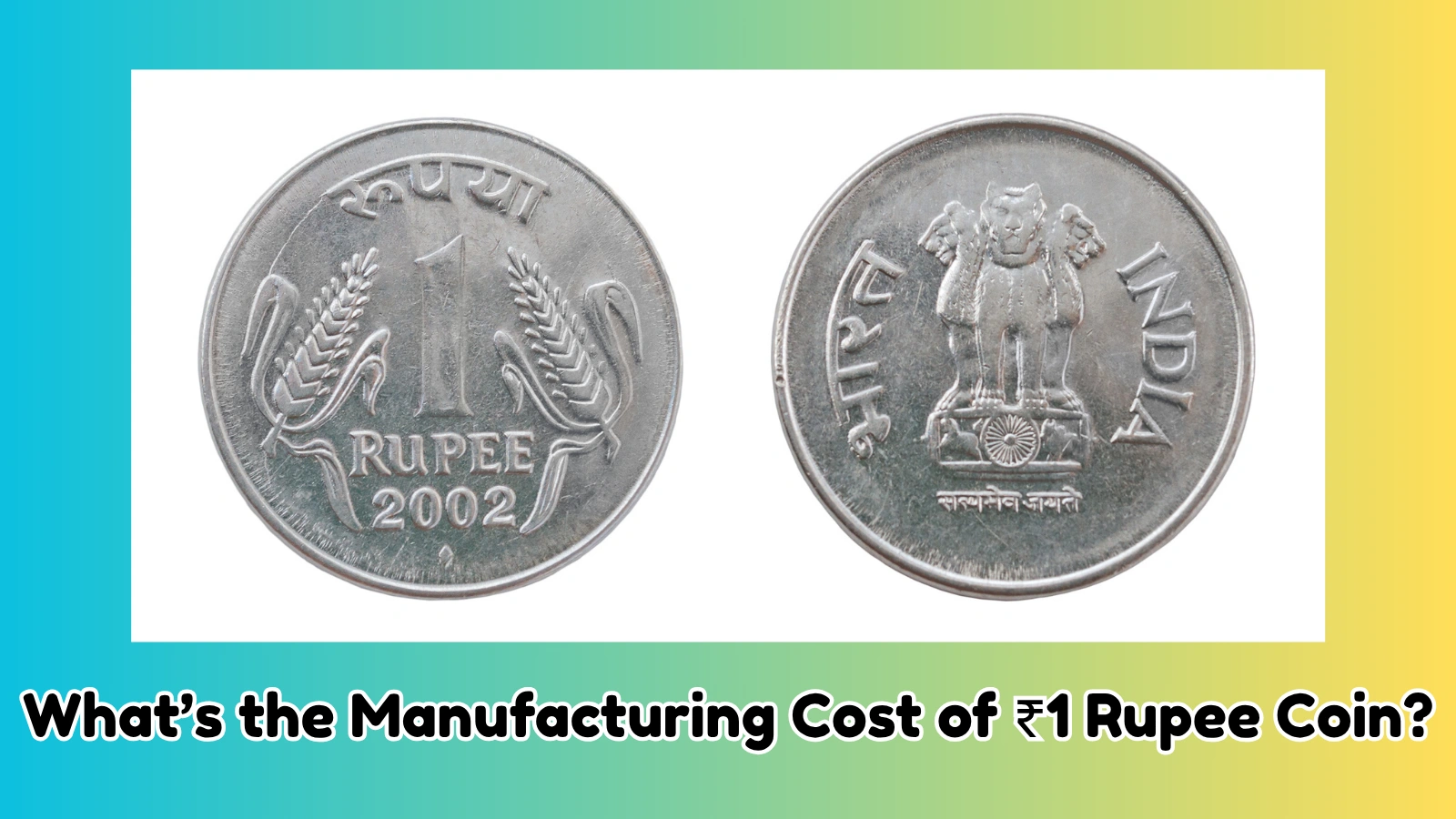Have you ever thought about how much it actually costs to make a ₹1 rupee coin? The real answer might surprise you. As per the latest reports, the manufacturing cost of one rupee coin in India is around ₹1.11. Yes, it’s more than the coin’s own face value! This means it costs more to produce the coin than its actual worth.

The ₹1 coin manufacturing cost includes raw materials, energy, labor, and other production charges. But why does it cost so much to make something worth just one rupee? Let’s explore this in detail.
In this article, you will find:
-
The real cost to mint one rupee coin.
-
Detailed coin production cost in India.
-
Insights into the coin manufacturing process in India.
-
Hidden costs and unknown facts about the ₹1 coin minting price.
Let’s dive into this exciting journey of Indian coin manufacturing!
Manufacturing Cost of Indian Coins – Complete Table
| Denomination | Face Value (₹) | Manufacturing Cost (Approx.) ₹ | Cost vs Value | Remarks |
|---|---|---|---|---|
| ₹1 Coin | 1.00 | 1.11–1.28 | Costs more (₹0.11–₹0.28 loss) | Cost exceeds face value. |
| ₹2 Coin | 2.00 | 1.28 | Costs less (₹0.72 gain) | Standard stainless steel coin. |
| ₹5 Coin | 5.00 | 3.69 | Costs less (₹1.31 gain) | Cost-efficient denomination. |
| ₹10 Coin | 10.00 | 5.54 | Costs less (₹4.46 gain) | Best margin among common coins. |
| ₹20 Coin | 20.00 | Not officially disclosed | Likely cost-effective | New bimetallic coin introduced in 2019. |
Key Insights
-
The manufacturing cost of one rupee coin is higher than its face value, making it a costlier coin to produce.
-
Coins of ₹2, ₹5, ₹10, and ₹20 are more economical to mint as their production cost is lower than their face value.
-
The ₹20 coin, introduced in 2019, uses a bimetallic design and is expected to be cost-efficient.
Disclaimer: The manufacturing costs mentioned above are based on the latest available information as of 2024. Actual costs may vary over time due to changes in raw material prices, energy costs, and government minting strategies. The manufacturing cost of the ₹20 coin has not been officially disclosed yet. This table is for informational and educational purposes only. Please consult official government sources for the most accurate and updated figures.
Section 1: Understanding the Basics of ₹1 Coin Manufacturing
What Does It Mean to Manufacture a Coin?
The coin production process in India is not as simple as pressing metal into a shape. It involves selecting the right materials, following strict security procedures, and using advanced machinery. The ₹1 coin minting cost is a combination of these steps, which makes the final cost sometimes higher than the coin’s face value.
Why Does It Matter?
It’s important because when the cost to produce one rupee coin exceeds its value, it leads to a financial imbalance for the government. Printing and minting currency efficiently is crucial for managing national expenses.
Section 2: Coin Manufacturing Process in India – Step by Step
How Are ₹1 Coins Made?
The coin manufacturing process in India happens mainly at four government mints: Mumbai, Hyderabad, Kolkata, and Noida. Here’s the step-by-step process:
-
Raw Material Procurement
Stainless steel is typically used for ₹1 coins. -
Blank Preparation
Sheets of metal are cut into blank coins. -
Annealing
Blanks are softened using heat. -
Cleaning and Polishing
Coins are cleaned to remove any residue. -
Minting
Coins are stamped with designs and denominations. -
Quality Check
Each batch undergoes strict inspection. -
Distribution
Final coins are shipped to RBI and banks.
The cost of minting Indian coins rises with each step.
Section 3: Real Cost to Mint One Rupee Coin
What is the Actual Cost to Make ₹1 Coin?
The real cost to mint one rupee coin is about ₹1.11 as per recent government disclosures. Sometimes this cost may increase slightly due to fluctuations in material prices or energy costs.
This one rupee coin production cost includes:
-
Raw materials
-
Labour wages
-
Machinery operation
-
Energy consumption
-
Quality assurance.
Section 4: Cost Breakdown of ₹1 Coin
Detailed Analysis
Let’s understand the cost breakdown of ₹1 coin in India:
| Cost Component | Approximate Share |
|---|---|
| Raw Material (Stainless Steel) | 50% |
| Energy & Utilities | 20% |
| Labour | 15% |
| Minting & Machinery Costs | 10% |
| Logistics & Packaging | 5% |
This detailed breakup helps us understand the ₹1 coin production price more clearly.
Section 5: Why Does It Cost More Than Its Face Value?
Minting Cost vs Face Value of ₹1 Coin
One interesting fact is that the minting cost vs face value of ₹1 coin often does not balance. When the actual cost to make ₹1 coin is higher than its worth, the government suffers a small financial loss per coin.
This is not unique to India. Globally, many countries face the same issue with lower denomination coins.
List Of Months Of The Year In English.
Section 6: Hidden Costs and Production Secrets
Uncovering the Hidden Cost of One Rupee Coin
There are hidden costs of one rupee coin manufacturing that most people don’t know about:
-
Transportation to banks and currency chests.
-
Security during transport.
-
Storage facilities.
-
Waste management during production.
All these factors increase the coin manufacturing price in India.
Section 7: How Much Does It Cost to Mint Other Indian Coins?
The Indian coin production cost varies for each denomination:
-
₹1 Coin: ~₹1.11
-
₹2 Coin: ~₹1.28
-
₹5 Coin: ~₹3.69
-
₹10 Coin: ~₹5.54
So, the ₹1 coin minting price is actually one of the most inefficient for the government.
Section 8: Why Does the Government Still Produce ₹1 Coins?
Even though the one rupee coin minting cost is higher than its face value, the government continues production because:
-
₹1 coins are widely circulated.
-
Removing them could create transactional problems for the common people.
-
Coins last longer than paper notes, balancing long-term costs.
Section 9: What is the Future of ₹1 Coin Production?
Will the ₹1 Coin Continue?
Looking ahead, experts suggest that:
-
The cost to manufacture coins in India may drop if alternative, cheaper metals are used.
-
Digital payments might slowly reduce the need for small coins.
-
However, ₹1 coins still hold cultural and economic significance.
Some countries have discontinued their smallest coins when their production cost became unsustainable. India might explore this option in the future if the one rupee coin production secrets start affecting the national minting budget.
Conclusion
The manufacturing cost of one rupee coin is surprisingly higher than its face value, currently around ₹1.11 per coin. This covers the expenses for raw materials, energy, labor, machinery, and distribution.
Even though the ₹1 coin manufacturing cost is technically a loss-making process for the government, it remains a vital part of India’s cash economy. The coin’s long shelf life and social importance make it necessary for daily transactions.
Understanding the real cost to mint one rupee coin helps us appreciate the complex world of currency production and why governments around the world are constantly evaluating the practicality of continuing low-value coins.
FAQs
What is the manufacturing cost of one rupee coin in India?
The manufacturing cost is approximately ₹1.11 per coin as per recent disclosures.
How much does it cost to make ₹1 coin compared to its value?
It costs more to produce a ₹1 coin than its face value, making it a loss-making process.
Why does the ₹1 coin cost more to manufacture?
The cost includes raw materials, energy, labor, and transportation, which together exceed the coin’s face value.
Is India planning to stop ₹1 coin production?
There is no official announcement yet. The ₹1 coin is still widely used in daily transactions.
How does India’s coin minting cost compare to other countries?
Many countries face similar challenges with low denomination coins costing more than their face value.
6. Are there any hidden costs in ₹1 coin production?
Yes, hidden costs include security, storage, and waste management during the production process.
Where are ₹1 coins manufactured in India?
They are produced at government mints located in Mumbai, Hyderabad, Kolkata, and Noida.
Will digital payments reduce the need for ₹1 coins?
Yes, as digital transactions grow, the dependency on low-value coins like ₹1 may gradually decrease.
Join 25,000+ smart readers—don’t miss out!







